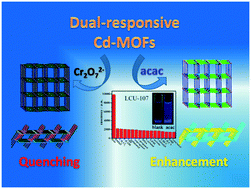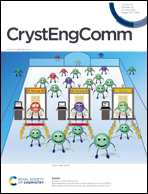Dual-responsive luminescent sensors based on two Cd-MOFs: rare enhancement toward acac and quenching toward Cr2O72−†
Abstract
Assembled from a reduced Schiff base tricarboxylate ligand H3L, two novel Cd-MOFs with the formulae {[Cd(HL)(bpy)]·1.25H2O·1.5DMF}n (LCU-107) and {[Cd(HL)(bpea)·H2O]·H2O·DMF}n (LCU-108) (where LCU stands for Liaocheng University, H3L = 5-(4-carboxybenzylamino)isophthalic acid, bpy = 4,4′-bipyridine, and bpea = 1,2-di(4-pyridyl)ethane), were obtained. LCU-107 possesses a 3D pcu framework based on dinuclear units. LCU-108 demonstrates an interesting 2D → 2D interdigitating and penetrating structure. The flexible carboxylate ligands can all bend in these complexes due to the rotation of –CH2–NH– groups. Luminescence measurements indicated that these two Cd-MOFs show highly selective and sensitive sensing activities toward acetylacetone (acac) and Cr2O72− through a luminescence enhancement and a quenching effect, respectively. The detection limits toward acac are as low as 0.136 and 0.058 ppm, respectively. To our knowledge, these two Cd-MOFs may represent very rare examples of special turn-on acac sensors, as well as being dual-responsive chemosensors for both acac and Cr2O72−.



 Please wait while we load your content...
Please wait while we load your content...